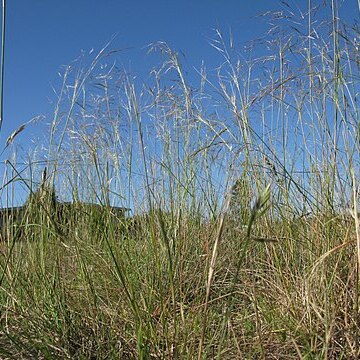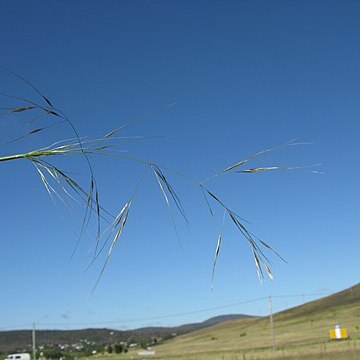Tall, erect, fine, perennial tussock, shoots very close set, slightly swollen at base; branching extravaginal; cataphylls hairy. Leaf-sheath to 10 cm, thin, very shortly retrorse pilose, occasionally with some long hairs. Ligule 0.2 mm, ciliate. Leaf-blade to 25 cm × 1 mm diam., stiff, weakly rolled, ribs few, abaxially finely retrorsely scabrid from columns of small prickle-teeth between ribs, abundant prickle-teeth adaxially and some few long hairs; margins with antrorse prickle-teeth and occasional long (1 mm) hairs. Culm to 60 cm, nodes retrorsely pilose, internodes below nodes densely retrorse-pilose, elsewhere sparsely scabrid. Panicle to 30 cm, narrow, subtended by tuft of hairs to 1.5 mm; branches short; rachis, branches and pedicels short stiff hairy. Glumes unequal, purple fading brown below, produced into hyaline awn-like processes to 2 mm, scabrid on nerves and above, > awn column; lower to 20 mm, 3-nerved, upper to 14 mm, 5-nerved. Lemma to 7 mm, clothed in dense white hairs, lobes minute (0.1 mm) ciliate; coma to 2 mm; awn to 50 mm, 1-geniculate, column to 10 mm tightly twisted, short hairy, arista to 40 mm. Palea weakly 2-nerved, internerve hairs few, apex ciliate. Callus to 2 mm, hairs to 3 mm. Lodicules 3, ligulate or emarginate, posterior and anterior equal, to 1.3 mm, or posterior shorter. Anthers to 4 mm, penicillate.
More
Plants to 1 m tall. Leaves: ligule 0.3–1 mm long, truncate; auricles usually with tufts of stiff hairs to 1 mm long; blade weakly rolled, c. 3 mm wide, slightly to strongly ribbed, scaberulous to scabrous. Inflorescence 25–45 cm long, contracted or open. Glumes unequal, 12–20 mm long, broad and inflated at middle, narrowed abruptly at tip. Callus (1.2–) 1.4–2.5 mm long, strong, curved, sericeous. Lemma cylindrical, 6–8.5 (–9.5) mm long, tuberculate, scabrous with antrorse hooks at apex, reddish brown at maturity, with white to yellow hairs; coma 1.2–2 mm long; lobes minute; awn 30–60 mm long, scaberulous, with column 12–22 (–26) mm long. Palea acuminate. Lodicules 3; abaxial lodicules broadly oblong to cuneate; paleal narrowly oblong.


